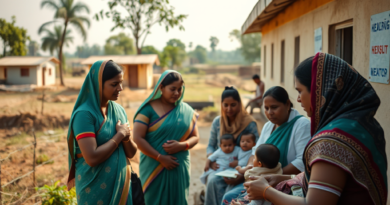Kumbh Mela
Context:
As over 2.3 lakh COVID-19 cases were reported in India on Saturday, Prime Minister Narendra Modi sought a curtailment of the Kumbh Mela underway in Haridwar, with the Juna akhara, a prominent congregation of Hindu seers, announcing that it was ending its participation in the event at his behest.
About Kumb Mela:
- Kumbh Mela or Kumbha Mela is a major pilgrimage and festival in Hinduism.
- It is celebrated in a cycle of approximately 12 years, to celebrate every revolution Brihaspati completes, at four river-bank pilgrimage sites: the Prayagraj/Allahabad (Ganges-Yamuna Sarasvati rivers confluence), Haridwar (Ganges), Nashik (Godavari), and Ujjain (Shipra).
- The festival is marked by a ritual dip in the waters, but it is also a celebration of community commerce with numerous fairs, education, religious discourses by saints, mass feedings of monks or the poor, and entertainment spectacle.
- The seekers believe that bathing in these rivers is a means to prāyaścitta (atonement, penance) for past mistakes, and that it cleanses them of their sins.
- The festival is traditionally credited to the 8th-century Hindu philosopher and saint Adi Shankara, as a part of his efforts to start major Hindu gatherings for philosophical discussions and debates along with Hindu monasteries across the Indian subcontinent.
- However, there is no historic literary evidence of these mass pilgrimages called “Kumbha Mela” prior to the 19th-century. There is ample evidence in historic manuscripts and inscriptions of an annual Magha Mela in Hinduism – with periodic larger gatherings after 6 or 12 years – where pilgrims gathered in massive numbers and where one of the rituals included a sacred dip in a river or holy tank.
- According to Kama MacLean, the socio-political developments during the colonial era and a reaction to the Orientalism led to the rebranding and remobilisation of the ancient Magha Mela as the modern era Kumbh Mela, particularly after the Indian Rebellion of 1857.
- The weeks over which the festival is observed cycle at each site approximately once every 12 years based on the Hindu luni-solar calendar.
- The festival is one of the largest peaceful gatherings in the world, and considered as the “world’s largest congregation of religious pilgrims”. It has been inscribed on the UNESCO’s Representative List of Intangible Cultural Heritage of Humanity.

Mythology of Kumbh Mela
Kumbh Mela is made up of two words Kumbh and Mela. The name Kumbh is derived from the immortal pot of nectar which the Devtas and the demons fought over as described in ancient Vedic scriptures known as the Puranas. Mela, as we all are familiar, is a Sanskrit word meaning ‘gathering’ or ‘to meet’.
The history of Kumbh Mela is related to the days when the Devtas and the Demons conjointly produced nectar of immortality as depicted by the legends. The Devtas and the demons agreed to complete the task together and decided to share the nectar of immorality in half. The Devtas and the demons then assembled on the shore of the milk ocean that lies in the celestial region of the cosmos. The churning of the milk ocean produced a deadly poison which Lord Shiva drank without being affected. After crossing through many hurdles years later, Dhanwantari appeared with the nectar of immortality in her hands.
The Devtas forcibly ceased the pot with its safety entrusted onto the four Gods – Brahaspati, Surya, Shani, and Chandra. Thereafter, the demons chased the Devtas for many days. During this time the drops of Kumbh dropped at 4 places Prayagraj, Haridwar, Ujjain, and Nashik. These four places are since then believed to have acquired mystical powers. The fight for the Kumbh i.e. the sacred pitcher between the Gods and demons continued for 12 divine days, which is considered to be as long as 12 years for humans. That is why the Kumbh Mela is celebrated once in 12 years and gathering took place on the above mentioned sacred places or holy sites. It is said that during this period the rivers turned into Amrit and so, several pilgrims from across the world visit the Kumbh Mela to bathe in the essence of purity and immortality.
Types of Kumbh Melas
Maha Kumbh Mela: It is held only in Prayagraj. It comes in every 144 years or after 12 Purna (Complete) Kumbh Mela.
Purna Kumbh Mela: It comes every 12 years. Mainly held at 4 Kumbh Mela Places in India i.e. Prayagraj, Haridwar, Nashik and Ujjain. It rotates every 12 years at these 4 places.
Ardh Kumbh Mela: It means Half Kumbh Mela which is held every 6 years in India only at two places i.e. Haridwar and Prayagraj.
Kumbh Mela: Held at four different places and is organised by the state governments. Millions of people participate with spiritual enthusiasm.
Magh Kumbh Mela: It is also known as Mini Kumbh Mela which is held annually and only at Prayagraj. It is organised in the month of Magh according to the Hindu Calendar.
The venue for Kumbh Mela is decided according to the position of the Sun, Moon and Jupiter hold in that period in different zodiac signs.
Since then, Kumbh Mela is celebrated with all the ritual beliefs and people from different aspects gather to celebrate the eve
| Place | River | Season, months |
| Haridwar | Ganga | Spring, Chaitra (January–April) |
| Prayag (Allahabad) | Ganga and Yamuna junction | Winter, Magha (January–February) |
| Trimbak-Nashik | Godavari | Summer, Bhadrapada (August–September) |
| Ujjain | Shipra | Spring, Vaisakha (April–May) |
Discover more from Simplified UPSC
Subscribe to get the latest posts sent to your email.



